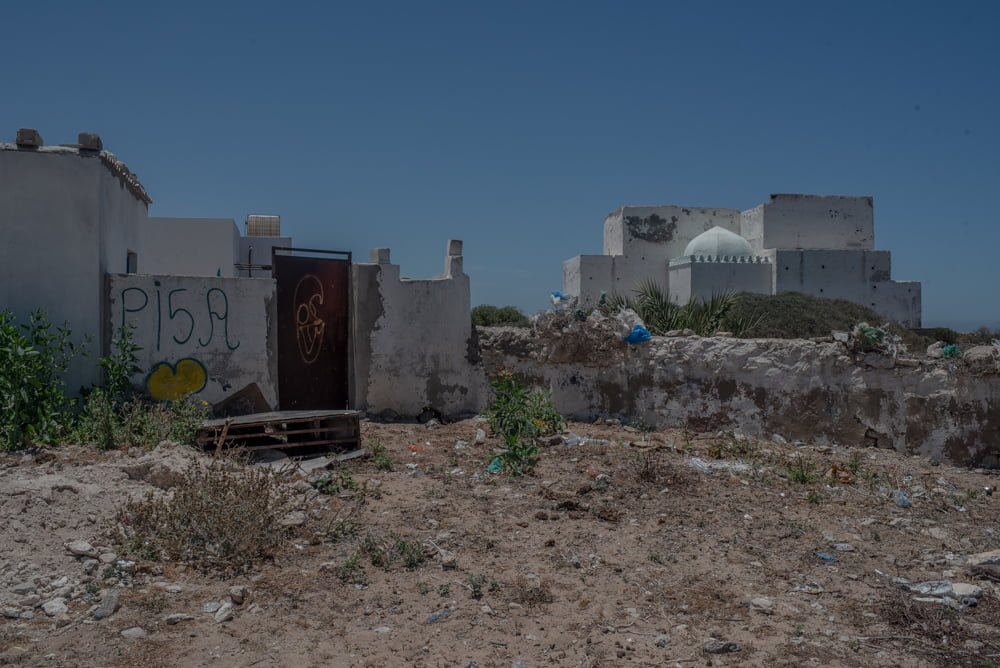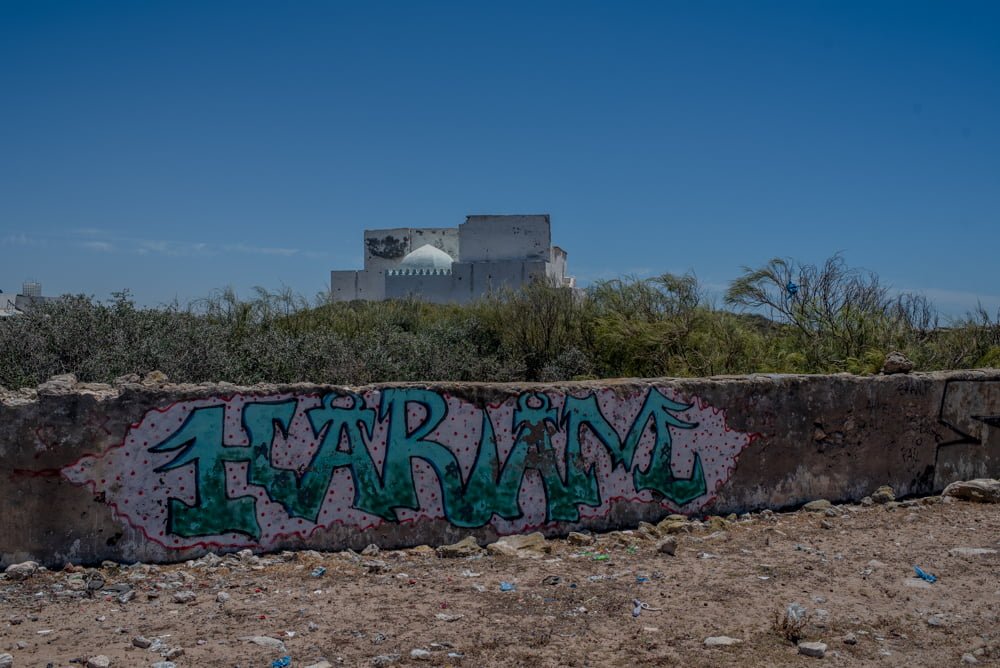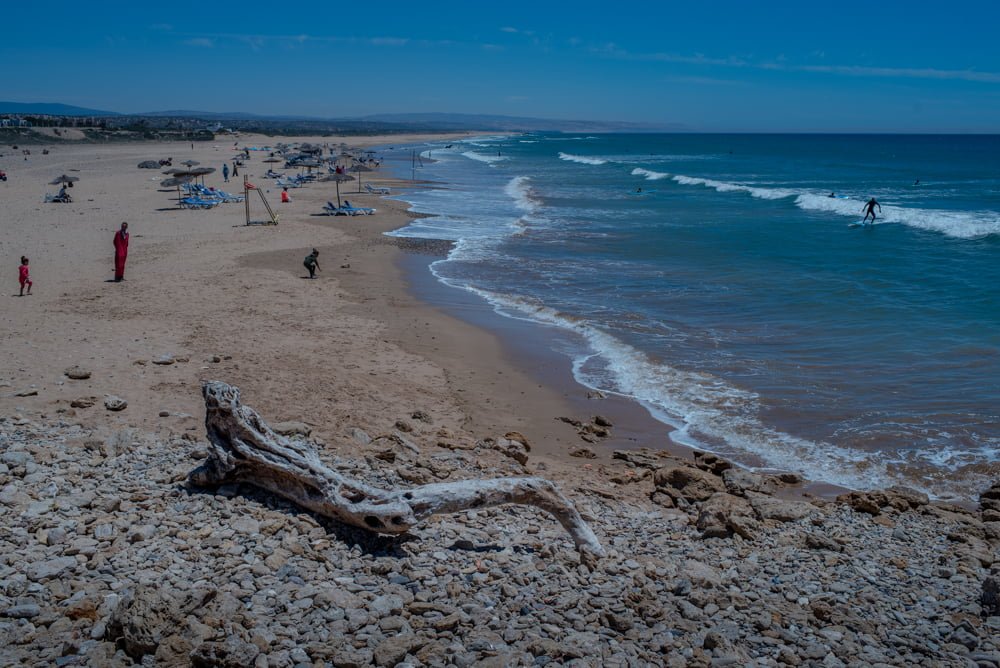Sidi Kaouki is a small town on the windswept Atlantic coast of west Morocco. Some 25 miles south of Essaouira, its long golden sands and dashing surf make it a favourite for surfers and windsurfers. There is a collection of stylish hotels, surfing and windsurfing schools, and lines of drying wetsuits around its environs, which attest to this interest.
Standing at the top of the beach, close to the coterie of cafes and shops, is a marabout shrine. Here the white building rises from the sandy beach as the largest structure close to the shoreline. This particular type of building is known as a Koubba, or Koubbeh, which is Arabic for dome or cupola. It specifically refers to a monument erected on the grave of a revered figure, or in a place where he ( or she ) stayed or lived.
These monuments occur mainly in North Africa and consist of a spherical dome built on a square, cubist building which forms a room, often decorated, which houses the tomb of a saint. They are normally quite small buildings, their size rarely exceeding 4 meters square.
‘The term Marabout appears during the Muslim conquest of North Africa. It is derived from the Arabic word “Mourabit” or “mrabet” (one who is garrisoned). Religious students and military volunteers who manned the Ribats (a fortified monastery, at the time of the conquest). Today marabout means “Saint” in the Berber language, and refers to Sufi Muslim teachers who lead lodge or school called a zaouïa, associated with a specific school or tradition, called a Tariqah (Tariqah: “way”, “path”)
The spread in sub-saharan Africa of the marabout’s role from the eighth through 13th centuries CE created in some places a mixture of roles with pre-Islamic priests and devines. Thus many fortune tellers and self styled spiritual guides take the name marabout (something rejected by more othodox Muslims and Sufi brotherhoods alike). The recent diaspora of West Africans (to Paris in particular) has brought this tradition to Europe and North America, where some marabouts advertise their services as fortune tellers.’
https://www.essaouira.nu/culture_marabout.htm
Sidi Kaouki takes its name from the 19th century marabout saint of the same name and attracts pilgrims from a wide area. ‘For the inhabitants of the nearby village Ida Ou Madda, Sidi Kaouki is a place of pilgrimage where it organizes Maârouf for the first haircut of the new – born. By this rite of passage, it puts the child, so to speak, under the protection of the sea marabout.
This pilgrimage is marked by a sacrifice, a communal meal and a dance collective ahouach.’
https://www.essaouira.nu/map_tours_sidi_kauki.htm
Looking up at the shrine from the sweeping beach there is no sign of the cupola which marks it out as a religious site. Looking at it from the north, the cupola becomes apparent and the building assumes its particular prominence. The front of the building currently appears to be a dwelling and the tomb is reached by following a small path to the right of the door below painted in a blue and black stripe. This path leads to a simple room where Sidi Kauki’s tomb is covered by a rich green and red cloth.
There is some decoration to the walls and the domed ceiling but the general atmoshpere is one of simplicity and contemplation. There is some expectation to leave a small sum of money on the cloth at the top of the tomb.
‘The spread in sub-saharan Africa of the marabout’s role from the eighth through 13th centuries CE created in some places a mixture of roles with pre-Islamic priests and devines. Thus many fortune tellers and self styled spiritual guides take the name marabout (something rejected by more othodox Muslims and Sufibrotherhoods alike). The recent diaspora of West Africans (to Paris in particular) has brought this tradition to Europe and North America, where some marabouts advertise their services as fortune tellers.’
https://www.essaouira.nu/culture_marabout.htm
‘Though not customary for most Muslims, the tradition of marabouts, or saints, and intercessory prayer continues to be observed in Morocco. People seeking healing, aid or enlightenment visit the tombs of such notables to gather in prayer.
The koubba is a burial ground and is seen as a holy ground. People make informal pilgrimages to the Marabout to reflect on life or to seek spiritual enlightenment. Some Marabouts are also visited because of the belief that the Marabout has miraculous healing powers, seeking Baraka
“Baraka refers to spiritual power that manifests in the form of a blessing or good fortune, similar to the concept of good karma in Buddhism. Murabitin are the individuals who possess good Baraka, similar to the concept of sainthood in Catholicism. Baraka may rub off on individuals who spend time with Murabitin. Also, most villages and medina neighborhoods have a fortune-teller who will charge to offer a vision, provide a remedy, or put a curse on someone. When news travels that pagan practices are taking place, Muslim missionaries will travel to the area to stop them and bring the people back to Islam.”
“Small dome-shaped temples are constructed for the Murabitin after their death, as they are thought to continue exuding spiritual power. Individuals seeking blessings, such as a woman who wishes to become pregnant, make pilgrimages to Murabitin temples.”
https://www.essaouira.nu/culture_marabout.htm










